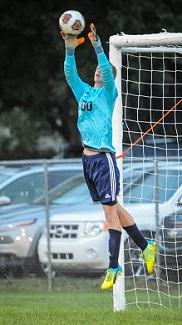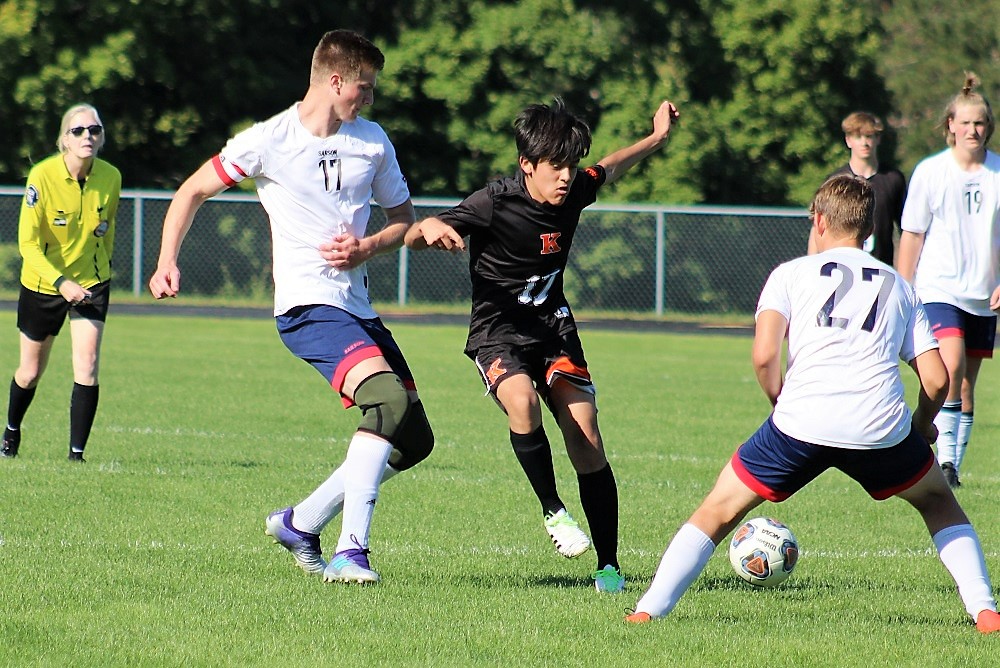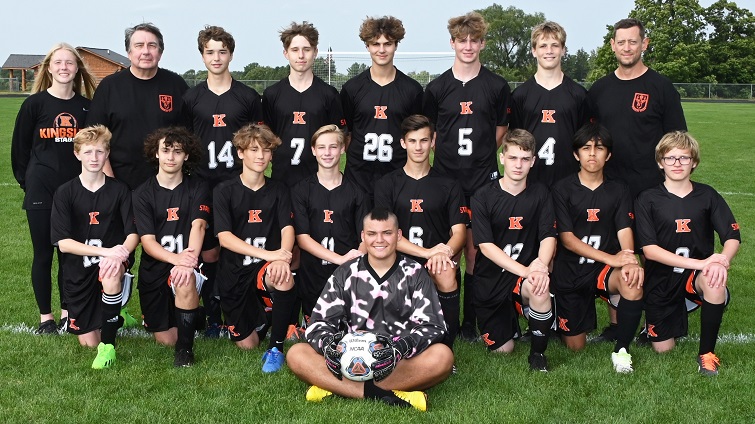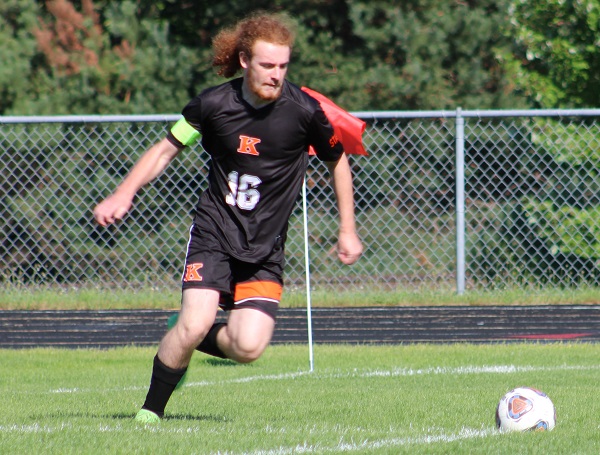
Performance: Mattawan's Casey Kirkbride
November 4, 2016
 Casey Kirkbride
Casey Kirkbride
Mattawan senior – Soccer
Kirkbride watched Mattawan’s run to the Division 2 Semifinals last season from the sideline – as a junior on the junior varsity, and one of two goalkeepers on that team at that. But the 6-foot-1 senior has made himself into a player capable of helping the Wildcats take another step this fall, and his four MHSAA tournament shutouts including last week’s over No. 8 Holland earned Kirkbride the Michigan National Guard “Performance of the Week.” Mattawan entered the postseason ranked No. 11 in Division 2, and this week also shut out top-ranked East Lansing 2-0 to reach an MHSAA championship game for the first time in this sport.
After he and his team surrendered own goals three times during the first four games this fall, Kirkbride has gone on to notch 13 shutouts over the team’s last 22 games with a season goals-against average of 0.68 and 0.88 save percentage. He made nine saves Wednesday against the Trojans and has the Wildcats at 21-4-2 after they graduated 11 players including six all-staters off the team that finished 23-3-1 a year ago.
 Kirkbride also played subvarsity basketball during his first two years of high school and should be in the running for academic all-state in soccer with a 3.73 grade-point average. He’s strongest in math and the sciences and is considering studying engineering in college, perhaps at Western Michigan University. But first, his team plays Dearborn Divine Child at 3 p.m. Saturday at Rochester Hills Stoney Creek for the Division 2 title.
Kirkbride also played subvarsity basketball during his first two years of high school and should be in the running for academic all-state in soccer with a 3.73 grade-point average. He’s strongest in math and the sciences and is considering studying engineering in college, perhaps at Western Michigan University. But first, his team plays Dearborn Divine Child at 3 p.m. Saturday at Rochester Hills Stoney Creek for the Division 2 title.
Coach Kirt Brown said: “He played JV for me last year and showed determination. He’s just got a great attitude. I talked to him (Wednesday) night; he was the first kid I went after when they were all hugging each other, and (I asked) if he would have thought at the beginning of the year he would shut out the number one team in the state semifinals. He’s been dynamite; he’s got a good defense in front of him, but he’s made some great saves as well. He’s long and rangy, and he’s got that never quit attitude. He’s kinda measured, and he’s learned and he’s grown as the year has gone on. He knows how important he is to our team, but he’d be the first to say ‘I have a really good defense in front of me.’”
Performance Point: “I’m just really thankful to have a good defensive line that limits the chances opponents have,” Kirkbride said. “They haven’t had too many clear opportunities where I’ve had to come up with saves, and I’m thankful for that. I try to keep (my defenders) organized, but they did a good job of being focused and really just staying strong on their marks; I try to help on that too. The one (save) that sticks out (from last week) is when the ball hit the post … I was in mid dive and it just went past my fingers and came back and hit off my face, and then it goes off for a corner. I was just thankful it didn’t bounce off my nose or a different part (and into the net).”
New team, all team: “I think (our success) comes down to being more of a team on the field because when we have chances to go forward we make the most out of them and we don’t give the ball up as much. We’re just on the same page more defensively and offensively. Having that sense of knowing teammates know what you want, because when you have the ball, they know how you want them to play. And we don’t have selfish players; for the most part, all of us are selfless and the goal is for the team.”
 On the move after Marshall: “Beating Marshall in the Regional Semis, it’s pretty close to greatness. We were outsized – they had some really big kids, and we never really had to face too much of that before. Seeing how we could handle it, we just played through it. We ended up conceding a goal right after halftime, but we didn’t drop our heads at all. Determination is really what that is. Our personnel, I’ve seen a lot of great things from these players, so I know we’re capable of it.”
On the move after Marshall: “Beating Marshall in the Regional Semis, it’s pretty close to greatness. We were outsized – they had some really big kids, and we never really had to face too much of that before. Seeing how we could handle it, we just played through it. We ended up conceding a goal right after halftime, but we didn’t drop our heads at all. Determination is really what that is. Our personnel, I’ve seen a lot of great things from these players, so I know we’re capable of it.”
JV as a junior: “It was tough last year because I was goalie part of the time, and another guy was goalie part of the time, and sometimes we didn’t know until the day of the game who would play, or that one would play one half and one would play the other. I kinda didn’t want to play goalie, but I definitely would not question if Coach wanted me. … I wasn’t so confident in myself (this season), but seeing (my teammates) were, that meant something to me. That’s how (important) being on a team of friends is. (I learned on JV) how important it is to make connections with your teammates. At the beginning of (last) season I didn’t have too much connection to my other teammates, but as the season progressed it got better.”
Quick thinking: “Playing goalie, you need to know decision making. Know the pros and cons without even thinking, that definitely comes into effect. If I have a decision in my mind, I’ll do it.”
- Geoff Kimmerly, Second Half editor
Every week during the 2016-17 school year, Second Half and the Michigan National Guard will recognize a “Performance of the Week" from among the MHSAA's 750 member high schools.
The Michigan Army National Guard provides trained and ready forces in support of the National Military Strategy, and responds as needed to state, local, and regional emergencies to ensure peace, order, and public safety. The Guard adds value to our communities through continuous interaction. National Guard soldiers are part of the local community. Guardsmen typically train one weekend per month and two weeks in the summer. This training maintains readiness when needed, be it either to defend our nation's freedom or protect lives and property of Michigan citizens during a local natural disaster.
Previous 2016-17 honorees:
Oct. 27: Colton Yesney, Negaunee cross country – Read
Oct. 20: Varun Shanker, Midland Dow tennis – Read
Oct. 13: Anne Forsyth, Ann Arbor Pioneer cross country – Read
Oct. 6: Shuaib Aljabaly, Coldwater cross country – Read
Sept. 29: Taylor Seaman, Brighton swimming & diving – Read
Sept. 22: Maggie Farrell, Battle Creek Lakeview cross country – Read
Sept. 15: Franki Strefling, Buchanan volleyball – Read
Sept. 8: Noah Jacobs, Corunna cross country – Read
PHOTOS: (Top) Mattawan keeper Casey Kirkbride (middle) gathers a loose ball against Stevensville Lakeshore earlier this season. (Middle) Kirkbride snags a shot against Lakeshore, which was ranked No. 16 in Division 2 at the time. (Photos by Steve Taylor@TSS Photography)

Records May Not Show It - Yet - But Kingsley Soccer Improving, Ready to Rise
By
Tom Spencer
Special for MHSAA.com
October 21, 2022
Kingsley did not go on unnoticed this fall in Northwest Conference soccer play.
 In fact, many took considerable notice of the Stags.
In fact, many took considerable notice of the Stags.
And, the coaches of the league’s top teams are looking for even bigger things ahead from Kingsley. Quite, frankly, they’re hoping it comes to fruition for their own teams’ sakes.
“It’s always beneficial to have a solid conference – as it helps teams prepare for playoffs,” said Rob Sirrine, coach of this year’s league title winner, Leland. “We expect them to improve in the next few years.
“Kingsley has had a rough go of it the last few years – not unlike other schools in our conference that also have football teams,” he continued. “I think they have some potential based on the coaches they have brought in and volunteers that are helping out the program.”
Second-year Kingsley head coach Tim VanWingerden welcomed Mike Alanson as a volunteer varsity assistant coach and two middle school coaches — Bert Baker and Lars Mitchell — this fall. Baker and Mitchell had kids on the Stags’ middle school squad this season.
League opponents, including the varsity coaches, noted big differences already.
Buckley coach John Vermilya, whose Bears finished second this year after winning the crown a year ago, echoed Sirrine.
“Kingsley has shown incredible resilience over the last three seasons,” Vermilya said. “This season they bounced back with an influx of young players, and you can see their growing tactical awareness along with technical ability.”
Youth soccer is growing in the Kingsley community as well, adding to the excitement. In fact, VanWindergen has two boys —Ted, 10, and Gunnar, 9, playing in the youth program. Tabatha VanWingerden, wife of the Stags’ head coach, is the coach of the U-12 team.
 Mitch Miggenburg, Kingsley’s athletic director, is pleased to see the growth in numbers as the Stags move through “a 3-5 year” plan to become more competitive in soccer and cross country. He’s hoping those sports can find success similar to that of the Stags’ football team.
Mitch Miggenburg, Kingsley’s athletic director, is pleased to see the growth in numbers as the Stags move through “a 3-5 year” plan to become more competitive in soccer and cross country. He’s hoping those sports can find success similar to that of the Stags’ football team.
Kingsley is 6-2 on the gridiron and looking ahead to the football playoffs again. The Stags are fielding a full squad of cross country runners this fall after some lean years.
With an enrollment of well under 500, Kingsley has been able to involve 62 boys in football, 10 in cross country and 17 in soccer. Miggenburg noted cuts had to be made to the school’s co-ed middle school team this fall.
“I think we’re headed in the right direction,” Miggenburg said. “If you look at our record, you might not see it.
“This is not something that is going to happen overnight,” he continued. “In order for us to develop the way we want to develop, we’ve got to put some time in outside the season. And we have some coaches willing to help and do that, and it will only benefit us in the future.”
The Stags have not won a game the last two seasons, but VanWingerden believes success, as defined by wins, is right around the corner. He knows his team has shown moments of brilliance in every contest before the goals mounted against the Stags.
VanWingerden and Kingsley have been praised for outstanding sportsmanship by referees, opposing players and coaches.
Other bright spots in 2022 included outstanding play by freshman goalie Nate Lamie and stellar defense by senior captain Zakkeus Bedford. The Stags will have to overcome the loss of Bedford, their only senior this year, who played with tremendous drive and was the leader on the field.
But, they should return rest of the squad hungry for wins. And, they’ll add some solid incoming freshman players.
 “I think next year is going to be a big turnaround,” VanWingerden predicted. “So the next two, three years, we’re going to start turning some heads.”
“I think next year is going to be a big turnaround,” VanWingerden predicted. “So the next two, three years, we’re going to start turning some heads.”
Despite not experiencing wins either of the last two seasons, the Stags have enjoyed playing soccer.
“There is a camaraderie there with these kids I just can’t quite put my finger on, but it’s part of what binds them better, facing that adversity on a regular basis and getting though it together as a team,” VanWingerden said. “They’ve come to practice the next day determined to work hard and try to improve little by little.
“The common goal to get better pulls them together and gives them a determination that is hard to find.”
Many conference games this year were played 9 vs. 9 or 10 vs. 10 per conference agreement. Benzie Central and Glen Lake played with fewer than 11 players in every contest this season. Benzie Central, Glen Lake, Kingsley and Suttons Bay all compete in cross country, football and soccer. Leland and Buckley do not field football squads.
The Comets won a District championship 1-0 on Thursday at Suttons Bay. The Bears are playing in a District Final on Saturday in Lakeview. Kingsley’s 0-19 season ended with a Division 3 District-opening loss to Boyne City last week.
The Stags have already begun working on next year. Offseason plans include drop-in soccer and participation in a newly-developed strength and conditioning program.
“The program is not going to move forward unless we put in a ton of work,” VanWingerden acknowledged. “We’ve had glimpses into what we could be if we did it on a regular basis.
“It is really encouraging.”
 Tom Spencer is a longtime MHSAA-registered basketball and soccer official, and former softball and baseball official, and he also has coached in the northern Lower Peninsula area. He previously has written for the Saginaw News, Bay County Sports Page and Midland Daily News. He can be reached at [email protected] with story ideas for Manistee, Wexford, Missaukee, Roscommon, Ogemaw, Iosco, Alcona, Oscoda, Crawford, Kalkaska, Grand Traverse, Benzie, Leelanau, Antrim, Otsego, Montmorency, Alpena, Presque Isle, Cheboygan, Charlevoix and Emmet counties.
Tom Spencer is a longtime MHSAA-registered basketball and soccer official, and former softball and baseball official, and he also has coached in the northern Lower Peninsula area. He previously has written for the Saginaw News, Bay County Sports Page and Midland Daily News. He can be reached at [email protected] with story ideas for Manistee, Wexford, Missaukee, Roscommon, Ogemaw, Iosco, Alcona, Oscoda, Crawford, Kalkaska, Grand Traverse, Benzie, Leelanau, Antrim, Otsego, Montmorency, Alpena, Presque Isle, Cheboygan, Charlevoix and Emmet counties.
PHOTOS (Top) Kingsley’s Rolando Torres works to gain possession against Traverse City Bulldogs’ Tyler Ritola (17), Jonathon Scott (27) and Syrus Ritola (19), as Josephine Arrowood officiates. (Middle) This fall’s Kingsley soccer team. (Below) Zakkeus Bedford lines up a kick this season. (Photos courtesy of the Kingsley athletic department.)

